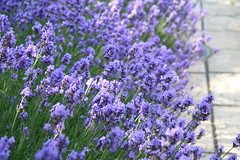| Lavender (Photo credit: The Heartwood) |
| Lavender (Photo credit: Pete Reed) |
| Lavandula stoechas (Photo credit: Wikipedia) |
If you live in a humid area, you'll have a tougher time growing lavender as most varieties prefer to grow where it is hot and dry.
You still may be able to grow some lavender varieties, just choose the site and variety carefully or you'll be disappointed.
In a humid habitat, try the non-English varieties such as Spanish (Lavandula stoechas) or sweet lavender and be sure to choose a high and dry site. Lavenders will not tolerate wet, soggy ground or water that pools around the roots.
If you live in an arid or semi-arid environment, you're in luck. Feel free to choose which lavenders to grow from any of the English, non-English and Lavandin varieties.
If you live north of zone 5 though, it's best to start lavender seed indoors about eight weeks prior to the last frost or your plants may not bloom.The seed can take up to two weeks to germinate.
The English (L. angustifolia) varieties are among the popularly grown lavenders and as such are often referred to as common lavenders. The most popular varieties are Lavender vera, Hidcote and Munstead.
Lavender vera will be my choice for Rainbow's Acre, our little home on the lee side of the Black Hills at 3300 feet above sea level. In central Europe, lavender vera is grown in the mountains at elevations above 2500 feet. This is the variety that is prized for medicinal and aromatherapeutic uses.
We may also give Munstead a try, as this is the most drought-happy lavender available.
I love the rich, dark flowers and short stature of the Hidcote varieties (perfect for a lavender lawn), but unfortunately Hidcotes are not quite as drought-tolerant as most lavender varieties.
The lavandins are fast-growing plants that can reach the size of a small bush.These lavender hybrids are the most popular varieties for lavender bouquets, potpourri and scented wands. The lavandins are the most popular varieties for use in scented oils and cosmetics as they are very prolific and long-blooming. Some of the most popular varieties are lavender grosso and Provence.
The non-English varieties can be a bit confusing. Lavender stoechas is referred to as both Spanish and French lavender. For the sake of consistency, I will call L. stoechas Spanish lavender. French lavender is properly L. dentata and its hybrids.
Whatever you call them, these varieties are generally grown for their beautiful flowers and are more for the gardener who wants a nice-looking plant than for those growing lavender for its products.
These varieties bloom in early to mid-spring and as such they need a warmer climate (zone 7 and south, unless you start seeds indoors further north).
After lavender plants flower, be sure to prune rather aggressively to keep them from getting rangy. All lavender varieties should be pruned after flowering, and don't worry after the flowers are done for the year - you'll still have a beautiful plant with fragrant foliage.
Lavender blooms should be harvested during cool, dry times in the early morning or early evening. If you harvest when it's hot out, you risk losing most of the fragrant oils that make lavenders so intoxicating.
The stems of varieties like grosso are long and sturdy enough to be woven into wands. Provence is great for potpourri as the flowers are easily removed from the stems. The English lavenders are useful for medicinal purposes, but they produce less oil than the larger Lavandins. Use the lavandins if you need a larger quantity of essential oil for cosmetics or other scented items.
Have you ever grown lavender? If so, which variety did you grow?
Related articles




Excellent post!! I love love lavender! We have two huge plants in our front yard, just next to the house and when the windows are open in the summer the smell is divine!
ReplyDeleteWe live in a dry, hot climate in Eastern WA state and I don't know what kind of lavender I planted, but it has thrived. We bought it from a local lavender farm who has acres and acres of lavender. It may be the happiest place on earth.
Last summer, we had so much lavender from our plants that we made lavender honey (honey infused with lavender buds) and lavender lemonade. It doesn't get better than that!!
Glad you enjoyed the post Lisa, sounds like we share a love for lavender!
Deletei have never tried to grow it--i love the way it looks but don't love the fragrance---i have heard you can eat lavender do you know if this is true---great blog
ReplyDeleteIt is edible - believe it or not lavender is a member of the mint family. Edible lavender dishes were especially popular during the Victorian era.
DeleteI've never grown lavendar but would love an entire field of it, please. :)
ReplyDeleteTeresa
I would like the same! Working on convincing they hubby that we need a lavender lawn.
Delete